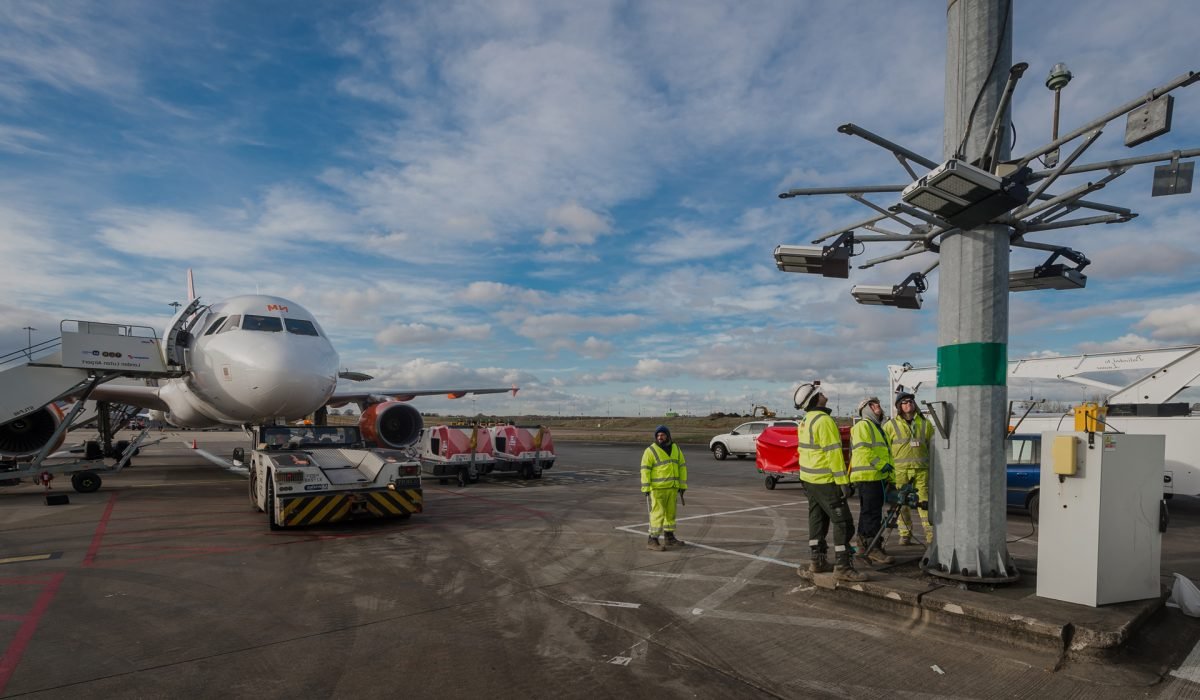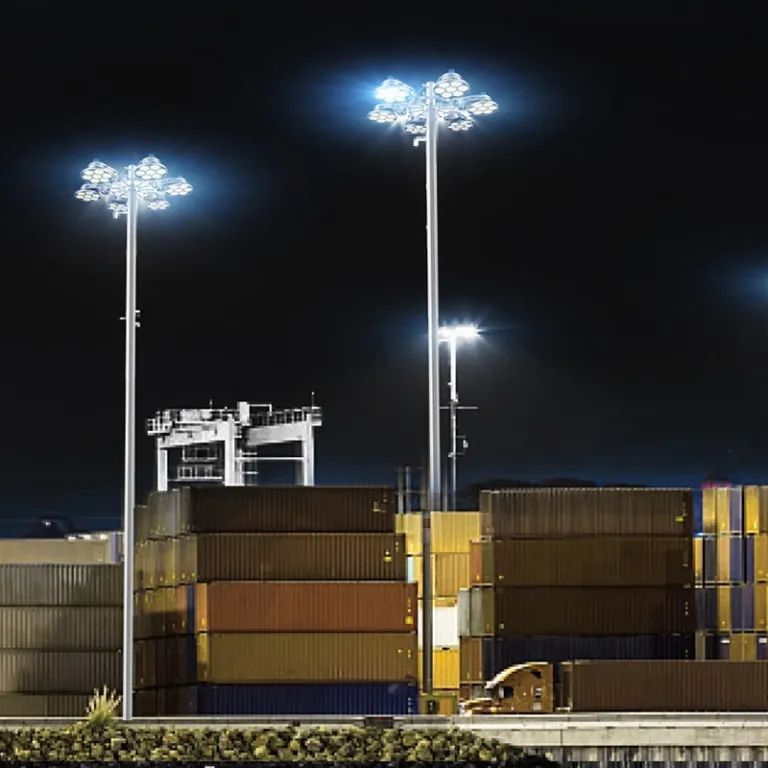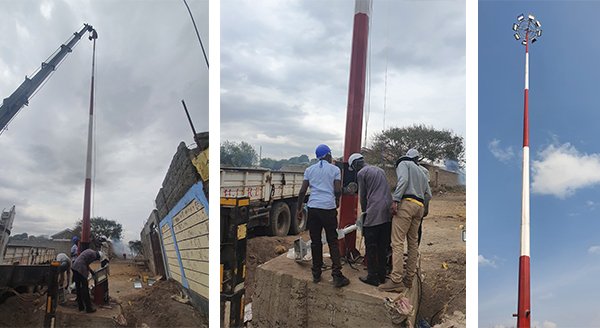High mast lighting transforms large industrial and public spaces — ports, highways, chemical plants, airports, and city squares — into safe, efficient, and intelligent environments. Across projects in Qatar, Nigeria, India, the Philippines, and Saudi Arabia, advanced LED and smart control systems have reduced energy use by over 40%, improved safety, and set new design standards for infrastructure lighting.
Why the Port Needed a Lighting Overhaul
Upgrading port lighting is critical when existing systems can no longer meet operational or safety requirements. A well-engineered high mast lighting system ensures uniform brightness, lowers maintenance costs, and supports round-the-clock logistics.
When I first walked through the East African port we were upgrading, the air was thick with salt and diesel fumes. Forklifts moved through half-lit lanes, and dockworkers joked they were “working by moonlight.”
That night, the need was obvious — we weren’t just replacing lamps; we were rebuilding confidence.
A similar transformation happened at Hamad Port in Doha, Qatar (Case 1) — a project that installed 136 high masts (35–45 m) with IoT-linked DALI control to meet ≥ 50 lux standards. Despite heat reaching 49 °C, the team completed the installation 18 days early, achieving 42.5% energy savings and 0.63 uniformity. It became Qatar Port Authority’s benchmark for intelligent coastal lighting.
| Item | Details |
|---|---|
| Location | East African port & Hamad Port, Qatar |
| Height | 35–45 m |
| Average Illuminance | ≥ 50 lux |
| Energy Saving | 42.5% |
| Control | DALI + IoT |
Before We Started: A Yard Lost in Its Own Shadows
Legacy high-pressure sodium systems often fail under coastal humidity and salt exposure, leading to poor illumination and high downtime. LED high mast retrofits restore visibility, reduce corrosion impact, and improve worker safety.
Before modernization, both our African yard and Doha terminal shared the same story — flickering lamps, rusted bolts, and patchy illumination below 15 lux.
The maintenance team had to hire cranes quarterly just to change bulbs.
At Hamad Port, corrosion control was elevated to C5-M level — triple-layer coating and zinc-aluminum hardware. Similar methods we later borrowed for another marine site in Mombasa saved years of repainting work.
The lesson was simple: in coastal environments, steel is never just steel — it’s a battle with the sea.
From Design Board to Dusty Ground
High mast lighting design balances optical precision, wind resistance, and corrosion control. Using photometric modeling and localized adjustments ensures uniformity and long-term durability.
We began with DIALux modeling — though I’ll admit, not everyone trusted the software. Amos, our senior technician, still used his handheld lux meter. “I don’t trust software’s eyes,” he grumbled — and he turned out right. Our first layout over-lit one container bay by nearly 20%.
In Doha, engineers used similar hybrid validation: simulations first, then on-site recalibration to achieve GR ≤ 45 glare level and uniformity ≥ 0.6.
Meanwhile, over in Lagos (Case 2), the challenge was different — no salt, but no power stability either. So we designed 240 hybrid solar + grid-powered masts along a 130 km expressway, with each unit running on 450 Wp PV modules and 2.4 kWh LiFePO₄ batteries.
Different climates, same formula: adaptability = survivability.
Unexpected Issues During Installation
Construction of high mast systems often encounters unpredictable conditions—heat, logistics delays, or restricted operations—requiring flexible scheduling and safety-first planning.
Those nights blurred together — 40-degree air, hot steel, and sea wind. Once, the crane’s oil pressure alarm froze a mast mid-air for twenty minutes. In Qatar, heat hit 49.3 °C, forcing the crew into night-shift operations under cooling tents.
In Lagos, construction took place with open traffic; the team used a “semi-closed sectional” method, finishing each 3 km zone in three days.
And in Gujarat, India (Case 3), our colleagues faced monsoon mud so deep that trucks had to lay temporary concrete roads just to reach the 40 m explosion-proof poles.
Every site wrote its own story of improvisation — and resilience.
The First Switch-On
Commissioning confirms design intent through measured illuminance, uniformity, and power factor tests. Successful high mast lighting activation visibly transforms operational safety and night visibility.
When we powered up our first batch in the port, everything felt different — quiet, white, almost cinematic light. You could see the cranes’ outlines clear against the night sky.
At Hamad Port, acceptance tests recorded 54.2 lux average, 0.63 uniformity, and power factor 0.97 — verified jointly by the Qatar Port Authority and a third-party lab.
At Cebu International Airport (Case 4), the first illumination test reached 72.4 lux, lighting up runways under strict CAAP inspection.
And on the Lagos Expressway, traffic police said accident rates dropped 35% year-on-year after switch-on.
Those numbers felt less like statistics, more like relief.
| Project | Average Lux | Uniformity | Energy Saving | Remark |
|---|---|---|---|---|
| Doha Port | 54.2 lux | 0.63 | 42.5% | Salt-resistant C5-M design |
| Lagos Hwy | 40 lux | 0.58 | 41.3% | Hybrid solar + grid |
| Gujarat Plant | 63.5 lux | 0.58 | — | Explosion-proof Ex d IIC T6 |
| Cebu Airport | 72.4 lux | 0.53 | 36% | Flight-linked automation |
| Riyadh Square | 56.8 lux | 0.6 | — | DMX dynamic lighting |
Counting the Money (and the Sleep Lost)
LED high mast upgrades deliver fast ROI—usually within 2–3 years—through lower power use and minimal maintenance. Long service life and modular design reduce lifecycle cost by more than one-third compared to traditional systems.
Our East African port saw its payback in a little over two years. The Doha team reported the same timeline.
| Cost Element | Old HPS | New LED | Reduction |
|---|---|---|---|
| 10-yr Energy | $2.3 M | $1.1 M | −52% |
| 10-yr Maintenance | $0.4 M | $0.05 M | −87% |
| Total | $3.6 M | $2.35 M | −35% overall |
Nigeria’s hybrid system saved another 34,000 kWh/month, while Cebu’s airport added redundancy with UPS backup — ensuring not a single blackout during flight operations.
Numbers don’t lie: light, when done right, pays for itself.
What We Learned the Hard Way
Every high mast project teaches different lessons — corrosion prevention for ports, solar-grid integration for highways, explosion safety for plants, and aesthetic control for public squares.
- In Qatar, we learned corrosion never sleeps — triple coating and anti-sea-breeze bolts saved us years later.
- In Nigeria, traffic management mattered more than wiring diagrams.
- In India, PLC control with Ex d protection proved safety can coexist with automation.
- In Cebu, aviation lighting synchronization pushed us into millisecond-level precision.
- In Riyadh (Case 5), we finally learned that light can be culture — DMX512-controlled 35 m masts now paint King’s Square gold during festivals.
Each site left something behind — a technical solution and a human story.
Why High Mast Lighting Still Matters
Modern infrastructure depends on adaptive, intelligent lighting to guarantee safety, productivity, and energy efficiency across industries—from ports and highways to airports and civic spaces.
Ports, highways, factories, airports, city squares — they all need the same thing: dependable light.
At Riyadh’s King Square, light isn’t just utility; it’s expression. The “Crescent of Light” mode, born from five nights of testing with local architects, now glows over the plaza during Ramadan.
In contrast, Gujarat’s chemical zone trusts light as its first safety barrier.
High mast lighting isn’t glamorous work, but it shapes the night where civilization keeps moving.
Afterthoughts
Ongoing monitoring, corrosion inspection, and system calibration ensure long-term stability. Sustainable lighting projects continue evolving through smart controls, local training, and human collaboration.
Even now, months later, I still receive WhatsApp photos from site teams — one from Lagos showing villagers under the solar masts they installed for free; another from Cebu, where the airport crew held a “Light of Cebu” ceremony during Holy Week.
These moments remind me that lighting isn’t just about lumens or lux — it’s about people seeing better, working safer, and belonging more.
In every project, the glow isn’t only on steel poles — it’s on faces.
CTA: Ready to upgrade your port or terminal lighting? [Request a customized high mast lighting — designed for real coastal life, not textbook conditions.






